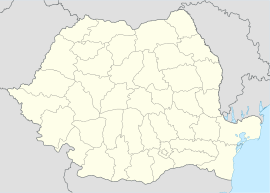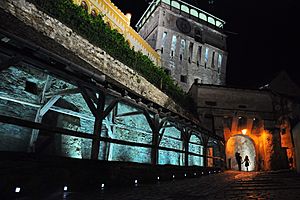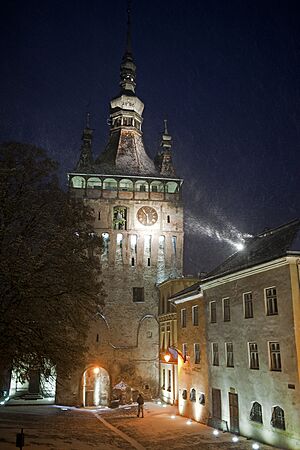Sighișoara facts for kids
Quick facts for kids
Sighișoara
German: Schäßburg
Transylvanian Saxon: Scheeßprich |
||
|---|---|---|
|
||
|
||

Location in Mureș County
|
||
| Country | ||
| County | Mureș | |
| Population
(2011)
|
Lua error in Module:Wd at line 1,575: attempt to index field 'wikibase' (a nil value). | |
| Time zone | EET/EEST (UTC+2/+3) | |
| Website | ||
| Official name: Historic Centre of Sighișoara | ||
| Type: | Cultural | |
| Criteria: | iii, v | |
| Designated: | 1999 (23rd session) | |
| Reference #: | 902 | |
| Region: | Europe | |
Sighișoara is a beautiful town in central Romania. It is located on the Târnava Mare River in Mureș County. Sighișoara is famous for its very old and well-kept old town. This old town is so special that UNESCO has listed it as a World Heritage Site. This means it is a place of great importance to the world.
About 24,000 people live in Sighișoara. It is a popular place for tourists to visit. The town also includes seven smaller villages: Angofa, Aurel Vlaicu, Hetiur, Rora, Șoromiclea, Venchi, and Viilor.
Contents
A Look Back in Time: Sighișoara's History
Sighișoara's story began in the mid-1100s. The King of Hungary, Géza II, invited German craftsmen and merchants to settle in Transylvania. These settlers were known as the Transylvanian Saxons. They helped protect the border and improve the economy.
By 1191, there was a Saxon settlement where Sighișoara is today. In 1280, a town was built on the site of an old Roman fort. It was called Castrum Sex, meaning "six-sided camp," because of its shape. The town got its official city status in 1367.
Sighișoara became a very important trading center in Central Europe. Many skilled workers from across the Holy Roman Empire came to the town. German artisans built strong walls to protect the city. In the 1500s and 1600s, Sighișoara had many different guilds (groups of craftsmen) and handicrafts.
A famous person connected to Sighișoara was Vlad Dracul. He was a leader from Wallachia and the father of Vlad the Impaler. Vlad Dracul lived in Sighișoara for a time. He even had coins made there. He also issued the first document that used the Romanian name, Sighișoara, in 1435.
The town faced tough times in the 1600s and 1700s. It was taken over by armies, suffered from fires, and had outbreaks of diseases.
In 1849, a big battle happened near Sighișoara, in a place called Albești. The Hungarian army fought against the Russian army. The Hungarian poet Sándor Petőfi is believed to have died in this battle. There are monuments in Albești to remember those who fought.
After World War I, Sighișoara became part of Romania.
Today, the central part of Sighișoara is a great example of a small medieval fortified town. It is a World Heritage Site because it has kept its old look so well. Every July, the town hosts a fun medieval festival.
Sighișoara is one of the few fortified towns in Eastern Europe where people still live inside the old walls. The town has two main parts. The old medieval fortress, called the Citadel (Cetatea), is on top of a hill. The newer part of the town is in the valley below.
The houses inside the Sighișoara Citadel show how craftsmen used to live. Some houses, like the Venetian House, belonged to important families.
Between 2001 and 2003, there was a plan to build a Dracula theme park near Sighișoara. However, many people and groups disagreed with the idea. They felt it would harm the town's medieval look and a nearby nature area. So, the park was never built.
People and Languages
| Historical population | ||
|---|---|---|
| Year | Pop. | ±% |
| 1910 | 10,913 | — |
| 1930 | 13,033 | +19.4% |
| 1948 | 18,284 | +40.3% |
| 1956 | 20,363 | +11.4% |
| 1966 | 25,109 | +23.3% |
| 1977 | 33,208 | +32.3% |
| 1992 | 36,170 | +8.9% |
| 2002 | 32,287 | −10.7% |
| 2011 | 28,102 | −13.0% |
| 2021 | 23,927 | −14.9% |
| Source: Official Romanian census data | ||
Most people in Sighișoara are Romanians (about 75%). There are also groups of Hungarians (about 17.6%), Roma (about 5.3%), and Germans (about 1.5%).
The town and its villages have different names in Romanian, German, and Hungarian:
| In Romanian | In German | In Hungarian |
|---|---|---|
| Sighișoara | Schäßburg | Segesvár |
| Angofa | Ungefug | Angofa |
| Aurel Vlaicu | N/A | Haufan |
| Hetiur | Marienburg bei Schäßburg |
Hétúr |
| Rora | Rohrau | Róra |
| Șoromiclea | N/A | N/A |
| Venchi | Wench | Venk |
| Viilor | Kulturberg | Szőlőskert |
What to See in Sighișoara
Sighișoara is a great place to visit, especially its old walled town. This area is a World Heritage Site. The most famous parts of the Citadel are its many towers. The town is also part of the Via Transilvanica, a long walking trail.
Amazing Towers
In the past, defense towers were built to protect a city. Each tower was like its own small fortress. If one tower was broken into, it didn't mean the whole city was lost. Many towers were hollow and had special ways to move things up and down, or even secret tunnels.
- Sighișoara Clock Tower (Turnul cu Ceas) – This is the most famous building in Sighișoara. It is 64 meters tall and was built in the 1200s. Today, it is a history museum.
- The Tinsmiths' Tower (Turnul Cositorarilor)
- The Butchers' Tower (Turnul Măcelarilor)
- The Bootmakers' Tower
- The Tailors' Tower (Turnul Croitorilor)
- The Furriers' Tower (Turnul Cojocarilor)
- The Ironsmiths' Tower (Turnul Fierarilor)
- The Ropemakers' Tower (Turnul Frânghierilor)
- The Tanners' Tower (Turnul Tăbăcarilor)
- The Face Tower – This tower is outside the main citadel but has an interesting story.
Important Churches
Sighișoara has several beautiful and historic churches:
- The Church on the Hill (Biserica din Deal) – This is one of the most important buildings in the city. It is a great example of Gothic architecture in Romania.
- The Monastery Church (Biserica Mânăstirii Dominicane) – This Gothic church is near the Clock Tower. It was built in the early 1200s. It is special because it does not have a bell. People believed the bell from the Church on the Hill was enough for the whole city.
- The Saint Joseph Roman Catholic Church
- Leprosy Church (Biserica Leproșilor)
- The Orthodox Cathedral of Sighișoara (Catedrala Ortodoxă)
- The Old Orthodox Church
Old Buildings and Architecture
Many of the 164 houses in Sighișoara are over 300 years old and are considered historical monuments. The houses in the Town Square (or Citadel Square) were once home to important families. The best houses are those that still look like they did a long time ago.
- House on the Rock (Casa de pe stâncă)
- House with Shingles (Evert) – This building is now used as an educational center for young people.
- Venetian House or Green House (Casa Venețiană)
- Vlad Dracul's House
- Sighișoara City Hall
- Sighișoara Hotel Complex – This building was once the city hall.
- Indoor Wooden Staircase or the Scholar's Stairs
- School on the Hill
- The Stag House (Casa cu Cerb)
- The Citadel Square (Piața Cetăți)
- Casa Asociatiei Mestesugaresti (La Perla)
- Joseph B. Teusch Building (Hotel Central Park)
Famous People from Sighișoara
Many notable people were born or lived in Sighișoara, including:
- Johann Michael Ackner, an archaeologist.
- Doina Cojocaru, a handball player.
- Friedrich Grünanger, an architect.
- Ralph Gunesch, a former German football player.
- Adrian Ivanițchi, a folk guitarist.
- Johannes Kelpius, a German thinker and musician who started a religious group in Pennsylvania.
- Gabriel Mureșan, a footballer.
- Marie Stritt, a German activist for women's rights.
- Georg Daniel Teutsch, a Lutheran bishop.
- Vlad III the Impaler, a prince who inspired the fictional character Count Dracula.
- Radu Voina, a former handball player and coach.
International Friends
Sighișoara has "twin towns" or "sister cities" around the world. This means they have special friendly relationships and often share ideas and cultures.
Images for kids
-
The Stag House (Romanian: Casa cu Cerb) in Sighișoara
See also
 In Spanish: Sighișoara para niños
In Spanish: Sighișoara para niños































